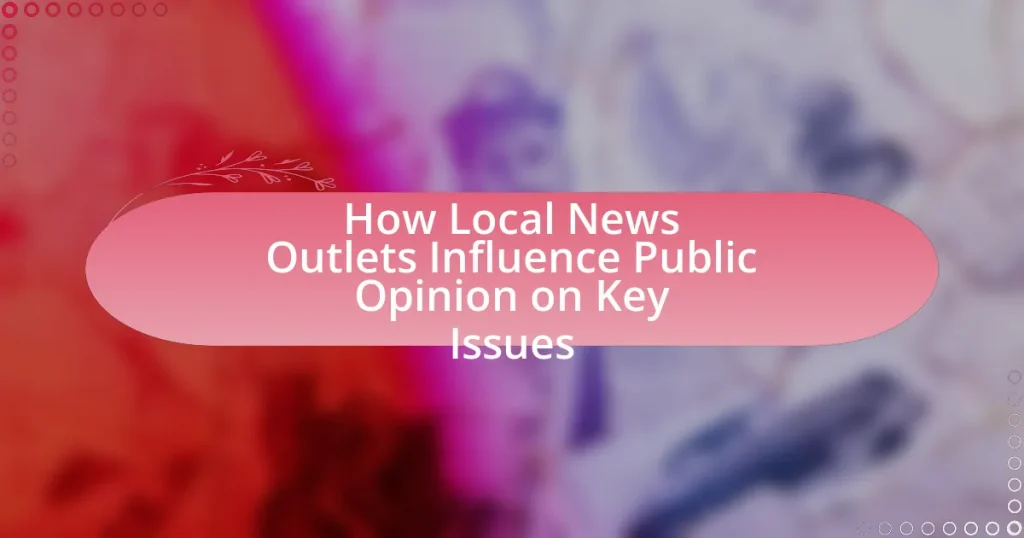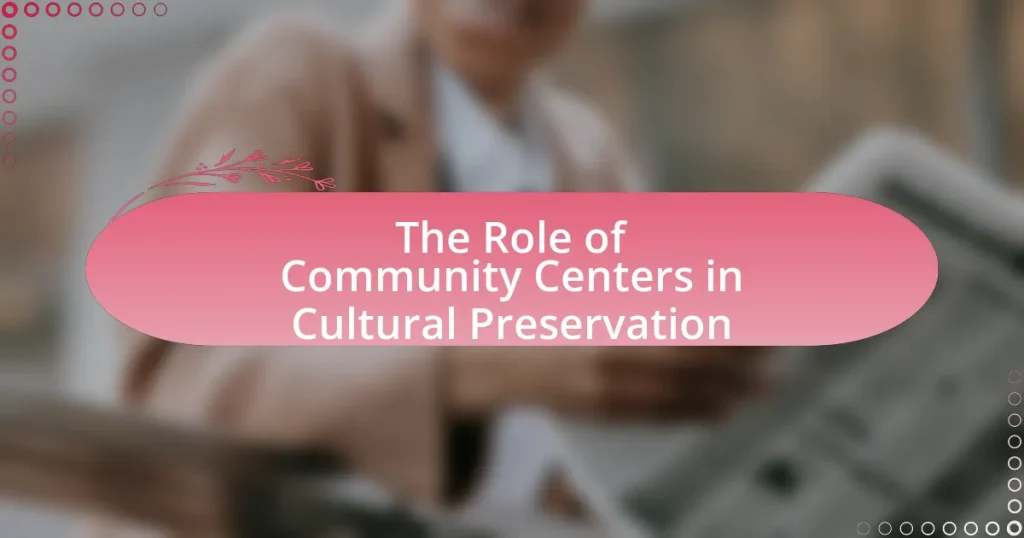Local news outlets play a critical role in shaping public opinion on key issues by providing localized coverage that addresses community-specific concerns. Their reporting influences perceptions of public safety, education, and governance, significantly impacting civic engagement and voter behavior. The article explores how local news outlets select issues to cover, the techniques they use to frame these issues, and the consequences of declining local news coverage. It also examines the importance of audience trust and engagement strategies that can enhance the influence of local news on public discourse and community awareness.

How do local news outlets shape public opinion on key issues?
Local news outlets shape public opinion on key issues by providing localized coverage that highlights community-specific concerns and events. This targeted reporting influences how residents perceive issues such as public safety, education, and local governance. For instance, studies show that local news can significantly affect voter behavior; a 2018 study published in the Journal of Communication found that increased exposure to local news correlates with higher voter turnout in local elections. Additionally, local news outlets often frame issues in ways that resonate with community values, thereby guiding public discourse and opinion formation.
What role do local news outlets play in informing the public?
Local news outlets play a crucial role in informing the public by providing timely and relevant information about community events, issues, and developments. They serve as a primary source of news that directly impacts residents’ lives, covering local government actions, public safety, education, and health matters. Research indicates that local news significantly influences public opinion; for instance, a study by the Pew Research Center found that 70% of Americans believe local news is essential for understanding their community. This demonstrates that local news outlets not only disseminate information but also shape civic engagement and public discourse.
How do local news outlets select which issues to cover?
Local news outlets select issues to cover based on factors such as community relevance, audience interest, and the potential impact on public opinion. They prioritize stories that resonate with local audiences, often influenced by feedback, social media trends, and ongoing events. For instance, a study by the Pew Research Center indicates that local news organizations often focus on issues that directly affect their communities, such as local government decisions, public safety, and community events, thereby shaping public discourse and opinion on these matters.
What impact does local news coverage have on community awareness?
Local news coverage significantly enhances community awareness by providing timely information about local events, issues, and resources. This coverage fosters a sense of connection among residents, as it highlights community concerns and achievements. Research indicates that communities with robust local news outlets experience higher civic engagement, as citizens are more informed about local governance and social issues. For instance, a study by the Pew Research Center found that local news consumers are more likely to participate in community activities and local elections, demonstrating the direct correlation between local news coverage and increased community awareness.
Why is local news important for public discourse?
Local news is crucial for public discourse because it provides community-specific information that shapes local opinions and civic engagement. By covering local events, issues, and governance, local news outlets facilitate informed discussions among residents, fostering a sense of community and accountability. Research indicates that communities with robust local news coverage experience higher voter turnout and civic participation, as reported by the Pew Research Center. This demonstrates that local news not only informs but also empowers citizens to engage actively in their communities, thereby enhancing the overall quality of public discourse.
How does local news contribute to civic engagement?
Local news contributes to civic engagement by providing residents with relevant information about community issues, events, and governance. This localized coverage fosters awareness and encourages participation in civic activities, such as town hall meetings and local elections. Studies show that communities with robust local news outlets experience higher voter turnout; for instance, a 2018 study by the University of Southern California found that local news exposure increased voter participation by 20%. By informing citizens about local matters, local news outlets empower individuals to make informed decisions and engage actively in their communities.
What are the consequences of a decline in local news outlets?
The decline in local news outlets leads to decreased community engagement and reduced access to vital information. As local news coverage diminishes, residents become less informed about local issues, events, and governance, which can result in lower voter turnout and diminished civic participation. Research indicates that communities with fewer local news sources experience a rise in misinformation, as citizens turn to less reliable platforms for news. A study by the Pew Research Center found that local news closures correlate with increased political polarization and a decline in public trust in media, further exacerbating the challenges of informed citizenship.
How do local news outlets influence perceptions of key issues?
Local news outlets influence perceptions of key issues by shaping the narratives and framing the context in which these issues are presented to the public. They determine which stories are covered, how they are reported, and the emphasis placed on certain aspects, thereby guiding audience understanding and opinions. For instance, studies have shown that local news coverage can significantly affect public perceptions of crime rates, community safety, and local governance, often leading to heightened concerns or misconceptions based on the frequency and tone of reporting. Research from the Pew Research Center indicates that local news plays a crucial role in informing citizens about local issues, which directly impacts civic engagement and public discourse.
What techniques do local news outlets use to frame issues?
Local news outlets use techniques such as selective emphasis, narrative framing, and the use of visuals to frame issues. Selective emphasis involves highlighting certain aspects of a story while downplaying others, which shapes public perception by directing attention to specific details. For example, a local news report on crime may focus on violent incidents in a neighborhood, influencing viewers to perceive that area as unsafe. Narrative framing involves constructing a storyline that resonates with the audience’s values and beliefs, often using familiar tropes or archetypes. This can be seen in how local news covers community events, portraying them as either celebratory or contentious based on the desired narrative. Additionally, the use of visuals, such as images and video clips, can evoke emotional responses and reinforce the framing of an issue, as studies show that visuals significantly impact audience engagement and interpretation. These techniques collectively influence how the public understands and reacts to key issues within their communities.
How does the tone of local news reporting affect public opinion?
The tone of local news reporting significantly influences public opinion by shaping perceptions and attitudes toward issues and events. For instance, a positive tone can foster community trust and engagement, while a negative tone may incite fear or distrust among the public. Research indicates that emotionally charged language in news stories can lead to heightened emotional responses, which in turn affect how individuals interpret information and form opinions. A study published in the Journal of Communication found that local news coverage with a negative tone about crime increased public fear and support for punitive measures, demonstrating the direct correlation between tone and public sentiment.
What are the challenges faced by local news outlets in influencing public opinion?
Local news outlets face significant challenges in influencing public opinion, primarily due to declining readership and financial constraints. The Pew Research Center reported that local newspapers have seen a 60% decline in advertising revenue since 2006, which limits their ability to invest in quality journalism. Additionally, competition from digital platforms and social media has fragmented audiences, making it difficult for local news to reach and engage the community effectively. Furthermore, the rise of misinformation complicates the landscape, as local outlets struggle to establish credibility amidst a plethora of unverified sources. These factors collectively hinder the capacity of local news outlets to shape public discourse and opinion on key issues.
How do financial constraints impact local news coverage?
Financial constraints significantly reduce the quality and quantity of local news coverage. When local news outlets face budget cuts, they often have to downsize staff, leading to fewer reporters covering essential community issues. According to a study by the Pew Research Center, between 2004 and 2019, the number of local newspaper journalists in the U.S. decreased by nearly 60%, which directly correlates with a decline in local news reporting. This reduction in coverage can result in less accountability for local governments and businesses, ultimately diminishing public engagement and informed citizenry.
What role does audience trust play in the effectiveness of local news?
Audience trust is crucial for the effectiveness of local news, as it directly influences the audience’s engagement and perception of the information presented. When local news outlets are trusted, audiences are more likely to consume their content, share it within their communities, and act upon the information provided. Research indicates that trust in local news correlates with higher levels of civic participation and informed decision-making among the public. For instance, a study by the Pew Research Center found that 70% of Americans believe local news is important for their community, and those who trust their local news sources are more likely to stay informed about local issues and participate in community events. This trust fosters a sense of credibility, which enhances the overall impact of local news on public opinion and community engagement.
How can local news outlets improve their influence on public opinion?
Local news outlets can improve their influence on public opinion by enhancing their engagement with the community and providing accurate, relevant reporting. By actively involving local citizens in discussions through forums, social media, and community events, these outlets can foster a sense of trust and relevance. Research indicates that local news organizations that prioritize transparency and accountability in their reporting see increased audience loyalty and trust, which directly correlates with their influence on public opinion. For instance, a study by the Pew Research Center found that 71% of local news consumers believe that local news is important for their community, highlighting the potential for local outlets to shape public discourse effectively.
What strategies can local news outlets employ to engage their audience?
Local news outlets can engage their audience by utilizing community-focused reporting, interactive digital platforms, and social media engagement. Community-focused reporting allows outlets to cover local events, issues, and stories that resonate with residents, fostering a sense of connection and relevance. Interactive digital platforms, such as websites and mobile apps, enable audiences to access news on-demand and participate in discussions, enhancing engagement. Social media engagement allows local news outlets to share content, interact with followers, and gather feedback, which can increase audience loyalty and participation. According to a Pew Research Center study, 70% of local news consumers prefer news that reflects their community, highlighting the effectiveness of these strategies in audience engagement.
How can local news outlets build trust within their communities?
Local news outlets can build trust within their communities by prioritizing transparency and accountability in their reporting. By openly sharing their sources, methodologies, and any potential conflicts of interest, these outlets demonstrate a commitment to honesty. Research indicates that 73% of Americans believe that transparency in journalism is crucial for building trust (Pew Research Center, 2021). Additionally, engaging with the community through local events, feedback mechanisms, and social media interactions fosters a sense of connection and responsiveness. This approach not only enhances credibility but also aligns the news outlet’s mission with the community’s needs and values.
What best practices can local news outlets adopt to effectively influence public opinion?
Local news outlets can effectively influence public opinion by prioritizing accuracy, engaging storytelling, and community involvement. Accuracy ensures that the information presented is credible, which builds trust among the audience; for instance, a study by the Pew Research Center found that 62% of Americans believe local news is more trustworthy than national news. Engaging storytelling captures the audience’s attention and makes complex issues relatable, as demonstrated by successful local news segments that highlight personal stories related to broader topics. Community involvement, such as hosting public forums or collaborating with local organizations, fosters a sense of ownership and encourages public discourse, which can lead to more informed opinions. These practices collectively enhance the outlet’s ability to shape public perception effectively.















